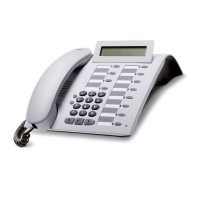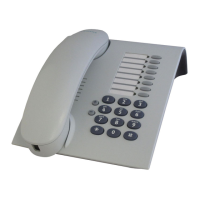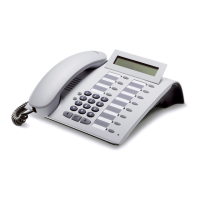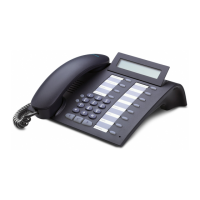
Do you have a question about the Siemens optiPoint 500 basic and is the answer not in the manual?
| Buttons | Yes |
|---|---|
| Navigation Keys | Yes |
| Speakerphone | Yes |
| Headset Port | Yes |
| Wall Mountable | Yes |
| Type | Digital phone |
| Display | 2-line LCD |
| Keypad | 12-key |
Provides essential safety and operational guidelines for the telephone.
Explains conformity marks and environmental compliance.
Describes the control panel layout and keys for specific models.
Details the control panel and key modules for the advanced model.
Explains how to interpret the instructions and symbols used.
Describes the format and content of telephone screen prompts.
Explains different methods to access telephone functions.
Lists and categorizes the available telephone functions.
Provides tips for efficient telephone usage.
Details how to answer incoming calls using different methods.
Step-by-step guide to answering calls using the handset.
Describes switching between speakerphone and handset modes.
Covers basic dialing and call termination procedures.
Instructions on how to redial previously dialed numbers.
How to mute or unmute the microphone during a call.
How to manage multiple callers and switch between them.
Process for transferring a call to another person.
Explains how to forward incoming calls to another destination.
How to set up a callback when a line is busy.
Programming frequently used numbers to specific keys.
How to dial numbers using saved repertory keys.
Adjusting various telephone settings like ring volume and tone.
Optimizing speakerphone and display settings.
Adjusting contrast, backlight, and screen language.
Handling incoming calls, including specific colleague calls and rejections.
Instructions for using the speakerphone feature for calls.
How to answer calls using a connected headset.
Communicating with visitors and opening doors via the entrance phone.
Activating and deactivating the door opener.
Procedures for dialing numbers, including en-bloc sending and correction.
How to view and manage incoming call records.
Viewing call details and redialing from the list.
Setting up and using speed dial numbers.
How to find and dial numbers from the internal phone directory.
Searching and dialing numbers using an external LDAP database.
Accessing and managing voice messages or similar.
Joining calls secretly and automatic call setup.
Reserving trunk lines and assigning DID numbers.
Using dialing aids for easier call setup.
Functions available while on an active call.
Managing incoming calls while already on a call.
Controlling call waiting signals and alert tones.
How to place calls on hold and retrieve them later.
How to put calls on hold and retrieve them.
How to set up and manage multi-party conference calls.
Ending conferences and removing participants.
How to use DTMF signals for device control.
Instructions for recording phone conversations.
Transferring a call with an announcement to a group.
Using trunk flash for ISDN services.
Troubleshooting for unreachable destinations and busy lines.
Setting up the phone to answer calls during non-office hours.
How to save functions, procedures, and appointments to keys.
Saving multi-step procedures to a single key.
Setting up timed reminders and appointments.
How the telephone alerts you for saved appointments.
How to view the cost of calls.
How to view call charges for other phones.
Assigning project codes to external calls.
How to disable the ringer and activate the DND feature.
Suppressing caller ID and secretly listening to calls.
Using the telephone to monitor sounds in a room.
How to identify unknown callers.
How to lock the telephone to prevent misuse.
How to remotely lock other telephones.
How to set and manage your personal identification number.
How to send short text messages to other users.
Managing sent and received text messages.
How to leave and delete messages for callers when you are away.
Shows the count of waiting calls and overload status.
How others can use your phone for outgoing calls.
How to transfer your call number to another telephone.
How to reset activated telephone functions.
How to remotely activate/deactivate functions on other phones.
Accessing system functions remotely via phone.
Setting ISDN functions using code dialing.
Controlling computer programs or data services from the phone.
Interacting with PC applications via a CSTA interface.
Controlling external relays and handling sensor alerts.
Using the system for radio paging.
Activating or deactivating audible signals for group calls.
How to join or leave hunt groups/group calls.
How to answer calls for team members.
Setting up and managing ringing groups for multiple phones.
How incoming calls are distributed among agents.
Managing agent status and availability for UCD.
How to use trunk keys and interpret their LED status.
Answering, making, and holding calls using trunk keys.
Switching between calls and managing MULAP conferences.
How to forward calls on specific lines.
How to use DSS keys and interpret their LED status.
Transferring calls and accepting calls for team members.
Transferring calls directly to an executive and managing ringing.
Running diagnostic tests and checking key assignments.
How to exit hunt groups or group calls in a LAN environment.
Managing call forwarding from other HiPath phones over LAN.
Managing ringing groups across different HiPath systems via LAN.
How to control relays via other HiPath systems over LAN.
How to activate door openers via other HiPath systems over LAN.
Explains the 'Terminal Mode' for the application module.
Details the features and usage of the application module's keypad.
How to input text using the keypad and character mapping.
Overview of how functions appear on displays in HiPath 4000.
How to label telephone keys with functions or numbers.
How to attach self-adhesive call-number labels.
Information on where to find operating instructions.
Lists optional accessories for customizing the telephone.
Instructions for cleaning and maintaining the telephone.
Common problems and their solutions.
Explains common error messages and their resolutions.
Information on who to contact for persistent issues.
A cross-reference table of functions, access methods, and codes.
Details compliance with FCC rules and requirements.
Explains FCC regulations for digital devices and telephone connections.
Information on Industry Canada requirements for equipment.











